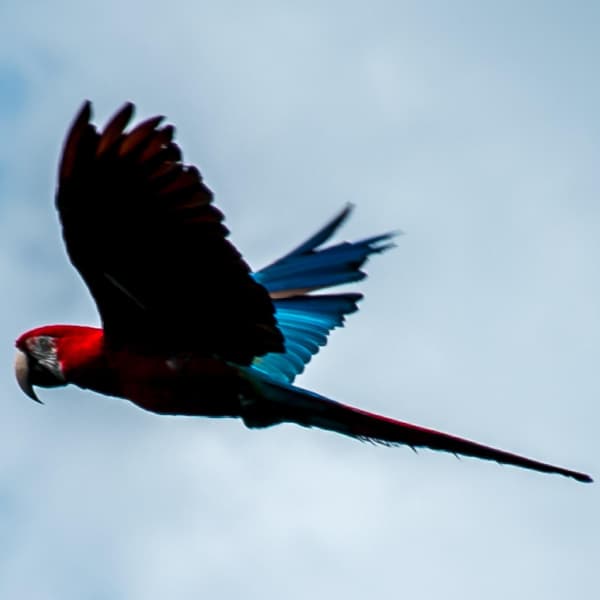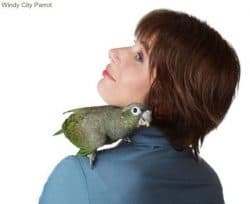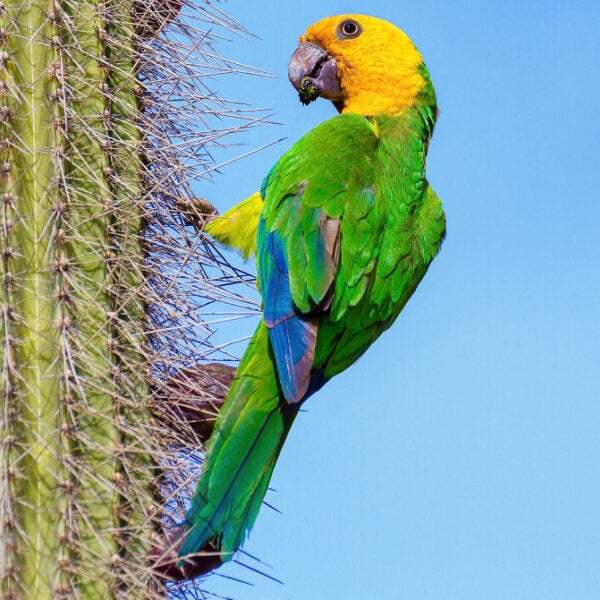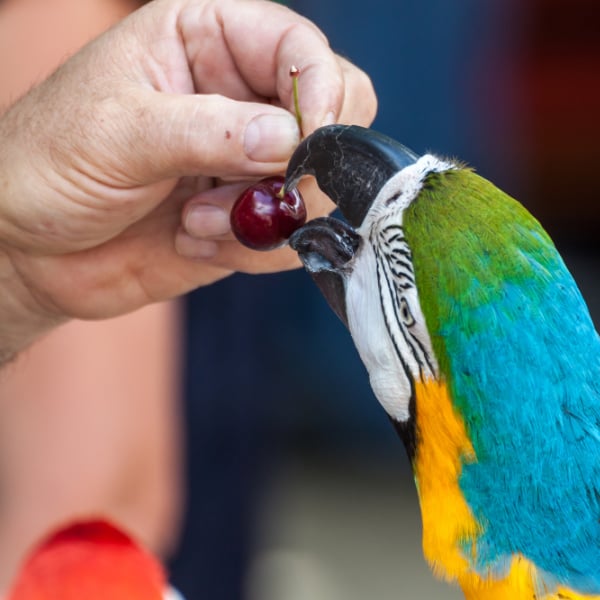Last Updated on by Catherine Tobsing
A Conversation with Glen Glendell, UK Parrot Behaviorist: Biting Parrots (Topic 1 of 3)
A while back, I had the opportunity to have a long teleconference with Greg Glendell, UK parrot behaviorist and author of several parrot training books.
Our discussion covered 3 main topics, at least one of which haunts many parrot owners. In each part of this series, I will summarize one of the key topics of our conversation, which covered:
- Biting Parrots
- Screaming Parrots
- Feather Plucking Parrots
In each topic, Greg drills into some of the reasons parrots may have these bad behaviors and what we can do to teach them to reduce or completely stop these bad behaviors. I found many of his thoughts, ideas and methods to be interesting, effective or thought-provoking.
We did disagree on one major topic. He believes that birds should never be stopped from flying and that a bird with clipped wings is being severely abused.
I think parrots face too many dangers in the home if they fly around the house while Greg feels that flight and flight commands are important.
I prefer not to have to use flight suits so flighted birds can safely go out to get at least 20 minutes of natural sunlight to help avoid Vitamin D deficiency and enjoy the outdoors safely without dangerous free flight or the use of flight suits.
Not clipping wings seems to be a common UK practice.
I know that some people like to teach their parrots to fly freely and return to them on command. I don’t like the idea of making my bird a potential food source for an eagle, hawk or osprey or the danger of the bird not returning for any other reason.
Our birds really do not adapt well to living in the wild, although there are cases of flocks of parrots living wild and free in the US. However, we have no idea of how many of these parrots died before adapting or were captured by predators.
Parrot Jungle in Miami allows some birds to free fly and advertises this fact.
When I visited, I asked about free flying and learned that only one member of the pairs of closely bonded birds are allowed to fly while the mates wait safely in their aviary home; then the mates get a turn to fly.
This pair bond makes the parrot feel an instinctual imperative to return to its mate. While parrots do bond to humans, the bond is never as strong as when bonded to a partner of the opposite sex.
Even an advanced center like Parrot Jungle, staffed by veterinarians, researchers and experts in the field of avians, do not trust their birds to free fly without having a major incentive to return home.
risky business but fun to watch
Now, lets get into biting and why parrots bite. From here forward, the content in this article reflects a summary of either what Greg Glendell said or my comments during our conversation with which he agreed.
Birds have a complex language used within their flocks, rarely biting a flock member in the wild. Once in a while two females might fight over a male if there is a shortage of males in their territory.
Males may nip and argue over females or there might be a snap if another parrot tries to look into the privacy of another bird’s nest. The parrot language involves the use of body language and sounds.
When we choose to live with parrots in our homes, it is our responsibility to learn as much of their language as we possibly can.
After all, we want them to learn our language so they can respond to commands and requests.
The parrots did not ask to be here and we cannot expect them to learn all of our language, though some do learn how to use whatever language is primarily spoken in the home in cognitive ways.
In our homes, birds bite humans because of some stimulus or stressor. It can be from fear, a person doing something they consider threatening, an activity going on that breaches their trust or something that is perceived as a threat.
These things evoke a flight or fight natural response, and often the bird chooses the fight solution and bites.
For example, a question had come up in response to a survey where someone wanted to know why his African Grey bit when he stuck his fingers into the top of the birds age.
Obviously the bird thought of this as a threat to its territory and the bird had every right to defend its territory from a threat.
Clearly the solution was to stop sticking fingers into the cage from the top and train the parrot basic manners commands such as stepping up onto a hand or perch when asked.
Most birds give a warning before biting, although it may be a quick warning. The bird is trying to communicate by using this warning.
For example, African Greys tend to make a clicking sound with their beaks and pin their eyes.
Greys will look at you quite hard and hold all their feathers down tight to their bodies. Amazons and macaws signal by flaring their tails and raising their head feathers.
Cockatoos will raise their crests, but there are many other reasons they raise their crests. Cockatoos will also hold their beaks open if the threat is not too near.
Greg suggests that companion parrot owners of any species of bird watch their bird and take the time to learn to read their birds body language as clearly as possible.
Biting often results from owners misreading their birds communications. The more a bird bites, the more the behavior is reinforced, resulting in more biting and creating a vicious cycle.
Never blame a bird for biting and do not punish the bird for it. Operate on a program of preventing being bitten by learning what your bird is communicating to you.
If you ask your bird to come out of its cage and it has been taught to do so when asked, if the bird refuses and indicates it may bite then there is a reason for the refusal such as getting ready to eat or nap.
The best way to react is to just back off and leave the bird alone for a while rather than provoking a bite.
Come back later and ask the bird to come out. If the bird is trained, alert and wanting to play it will come out willingly.
Avoid ever forcing a bird to do something when it is clearly refusing (the exception being a real emergency such as the house being on fire).
Instead, come back when the bird is more attentive and it will come right out of its cage to you.
After all, you do not like to be forced to skip a nap if you are tired or stop eating and socialize when you are hungry.
Humans don’t bite as a means of communication but we do become quite upset if someone insists we not be allowed to do what we need to do to take care of ourselves.
A great part of teaching a bird not to bite is training the human.
If the bird’s communications through body language and sounds is ignored and a bird is forced into doing something often by physical force, trust will be lost between the bird and owner and it is really hard to earn that trust back again.
Parrots love drama and when a person is bitten hard, they often react with drama shouting and jumping around.
The parrot does not interpret this reaction as a bad thing. It is entertained by this big show by its human companion. Since the only way to discipline a tame parrot is to remove your attention or remove your presence.
Jumping around or shouting will only reinforce the idea that if the bird bites, people will react in what it considers to be an amusing way, so it is likely to bite again to see the reaction.
I shared with Greg an incident that had happened to me that caused what appeared to be unprovoked biting by a loving, well-mannered sun conure.
I’d had a manicure and chose a nail polish that was really cool, sort of iridescent and it changed color a bit depending on how the light hit it. At home my aviary birds went a bit nutty when they saw me.
SunDance, my sun conure (deceased at age 25) refused to come to me and when she did come, she immediately bit me — and she was not a biter. I analyzed what had changed to cause this behavior.
The only thing I could think of was the color of my finger nails so I removed the polish. The birds returned to normal immediately so it had to be the nail polish. I asked Greg what might cause such a strange reaction.
would the birds have been more understanding of a bird manicure?
Greg told me some facts about how birds see. He told me that birds see literally thousands more colors than we do and some are warning colors.
Greg thought that the nail polish incident was likely caused of the birds seeing things in the nail polish that my limited color vision did not let me see and probably one of these colors was one the birds were afraid of.
Greg brought up the fact that birds deal quite well considering the changes that happen with their human companions.
We change clothes every day, sometimes several times a day, and this is dealt with well. We cut our hair so that one day we could have very long hair and straight but after a haircut and perm the person has short curly hair.
Some people change hair color. Think of what it would be like for you if you woke up one day an your beautiful green wing macaws were purple and then the next day they were yellow?
editor’s re-creation of color changing Macaws
OR
Humans probably would not deal with it very well if we never knew what our bird might look like from day to day.
Greg suggested that people put a lot of responsibility on the bird by expecting it to adapt while humans need to instead adapt to the bird’s needs.
Birds get tired and want to be left alone or they don’t want to stop eating to pop out and show your friend a trick.
We need to consider the bird’s feelings too, not making unreasonable demands on it. In the bird’s mind it should be allowed to still behave as its ancestors did in the rainforest.
Birds have not been domesticated for hundreds of years like dogs and cat.
Greg also brought up the fact that if a tame bird is allowed it to breed, we can’t expect it to want to be with its former human flock most of the time because it has fully bonded with a mate.
Parrots should either be companion birds or breeder birds and when humans try to make birds mix the two types of behavior big problems can result and one of the problems is biting because the formerly companion bird will now want to defend its mate and feels threatened when separated.
While a few parrots are quite tame when not breeding and then protective of mate, nest and babies when breeding, this is not by any means the norm.
A bird that has bonded to a mate and produced babies should not be expected to return to the behavior of a tame, trained parrot. Respect the birds bond and do not force unwanted interaction.
Greg suggests that if a bird truly bites for no reason at all, after you have learned to read their body language and no signal was given, and it bites hard the owner should remove themselves from the situation. It is never the birds fault.
Perhaps the warning signal was missed by the human; sometimes the signs are very short, just seconds long.
Don’t blame the bird but don’t stick around for another bite. Then, a few minutes later, no more than 3 or 4 minutes, return to the bird’s area and don’t approach the bird directly.
Wait for the bird to interact with you, offering a sign that it wants to be with you or interact with you.
This practice gives the bird an incentive not to bite hard. When it bites hard, you give it no attention but when it doesn’t bite hard it gets attention. This is a powerful way to show the bird how it should behave and reduces aggression.
Greg also said that a person who becomes fearful of a bird because it has bitten hard can teach the bird to step up onto a stick like a short perch.
By using a high-value food reward, this behavior is usually pretty easy to teach.
Then teach the bird to allow you to remove it from the cage on the stick and follow by other basic manners training, using food treats at first and moving to praise and perhaps scritches if the bird likes to be touched as a reward later in training.
Break the training to step onto the stick into small responses. On the first day if the bird even takes a step or two toward the hand or perch, reward it with praise and a favorite treat.
The next day, the bird should move closer to the hand or perch than the day before in order to earn the treat.
Continue the rewards for small improvements until the bird has to touch the intended perch to earn the reward and then ask it to step up onto the destination to earn the reward but don’t try to move the perch or hand yet.
After a few days of getting the bird comfortable just sitting on the perch or hand, moving the bird a very small bit toward the cage door and the bird should stay on the perch to get a treat. Each day, move closer to the door to earn the treat, eventually taking the bird outside the cage to earn its treat. This is a great first training behavior for untamed birds as well.
Never remove the bird’s food entirely, not feeding it until after training time. Keeping the bird so hungry that it will do anything to get food is poor training and bird abuse.
Perhaps reduce the food a bit so the bird wants the treat but birds should never be denied access to food, especially if you train late in the day.
Birds want to eat first thing in the morning. If you have time to train the bird before morning feeding, this can be great time for a short training session when using food treats.
Allow the bird time to poop first and keep the session short then immediately feed the bird its normal morning food.
It is important to mention that right from the start of training the human should use exactly the same training command that you intend to use when asking the bird to step up onto the stick.
Do not expect a bird to respond to “step up” one time and the next time say “up” or “come here”. The bird will only understand if you keep the command and expected reaction exactly the same each and every time.
Birds mourning a lost mate came up because of a survey response. The owner said her two year-old Quaker had recently lost its mate and it appeared depressed and would bite without seeming to provide a warning.
Greg said that chances are the bird did give a signal saying leave me alone I am mourning right now. He continued by suggesting that adding another mate soon or even a same-sex companion to provide company to the mourning bird should be considered to reduce the depression factor. Yes, birds do mourn.
If a companion bird is added don’t put them together without their being allowed to get used to one another.
Place them in cages next to each other and wait for them to begin to interact through their cage bars. Let them each have out of cage time but not at the same time at first.
Once they interact through the cage bars, allow them supervised out of cage time at the same time.
Watch for aggression from either bird. They may immediately decide to move into one cage or the other; if it does takes some time to reach the point they go into a cage together willingly, respect that choice.
Ideally, when the birds do interact together, you should change the interior of the cage in which they will live so that neither bird is territorial.
They will think of this new arrangement as new territory and potential aggression between the birds will be avoided.
Move toys around, buy new toys, move the position of food cups if practical (not all cages allow this), change perches around, adding some new ones.
Put two swings in the cage if there is room. Do a cage interior change before moving the two birds permanently into one cage.
Make the move early in the day on a day someone will be around continually to keep an eye that the two birds remain happy about the changes and removal of the other cage.
An issue some people have with their parrots is that they chew on furniture, walls, and curtains, anything they can get their beaks on. A bird is going to chew!
This is not a bad behavior at all, simply a natural behavior inherited from their wild ancestors.
In fact, chewing should be encouraged by providing lots and lots of wooden, rawhide, paper, wooden clothes pins, rope and other toys and other chewable objects in a bird cage and on play stands to allow them to chew and chew.
Chewing keeps beaks healthy and provides a form of entertainment. After all, most species of parrots in the wild chew holes in the trunks of threes inn order to create their nests.
Encourage the bird to chew the objects you would like it to chew.
nest building 101
Chewing actually solves quite a few other problems and is not a problem in itself as long as a parrot gets supervision when outside its cage.
If the bird is outside the cage and you see that it is about to chew something it shouldn’t, you should provide it with something that it should chew and it will soon learn to chew on the items you provide, as long as you keep them coming in plentiful amounts of varied colors, shapes and textures so that it remains interesting to the bird.
Praise the bird when it is chewing something that is acceptable to chew on.
A problem parrot owners often encounter is bonding with only one member of a family and biting everyone else that tries to interact with it.
In almost all families with birds, the bird will pick a favorite person and want to be with that person more than other family members. Some birds will prefer men while others prefer women and others never met a stranger.
Ideally, however, a companion parrot will interact with all family members at some level when the bird is not interacting with its favorite person.
The favorite person should avoid doing anything that the bird might interpret as pair bonding behavior or sexual stimulation when the bird appears to want to mate with their favorite person during breeding season.
Young children are high energy and a parrot should never be allowed to interact with children without supervision.
A parrot should not be expected to interact with every stranger that enters the home and it can’t be expected to like everybody. Birds are like people; we choose our friends based on how they treat us and other factors like loyalty, sharing fun, and so on.
Birds do much the same in selecting their friends. Allow a bird to get to know a new person before it is expected to interact with that person at all and allow the bird to indicate that it wants to interact with the new person in order to avoid bites.
If a just-weaned parrot enters the home as a companion parrot, begin teaching it right away what it should chew on and what not to chew by providing positive rewards when it chews on something it should.
All young birds have to learn how to behave and are likely to go through a period of nibbling on fingers and even gently biting to find out what is acceptable.
When the bird begins nibbling on a person, immediately provide something the bird can acceptably bite on and then praise it when it chews on the toy or other object that it is permitted to chew and bite.
This completes the summary of my conversation with Greg Glendell, professional parrot behaviorist from the UK and author of multiple books.
We spoke about this topic for over an hour and there were many more points on biting that I wish we had time to cover. If you are having any biting issues with a parrot in your life, I do hope something in our conversation will resonate with you, providing you with ideas of how to improve your parrot’s behavior or adjust your expectations when applicable.
In the next discussion summary, I will provide you with points from our long conversation that touched on dealing with screaming parrots. You can find out more about Greg Glendell at www.greg-parrots.co.uk
Written and Approved by the Windy City Parrot Content Team







Lisa
8 Oct 2017Thanks for this article! For better or worse, after 28 years together, my Amazons like to target me for fun sometimes. I have a great diversion tactic to add – when they’re looking saucy-threatening, sing! They truly love music, and I can change their attitude on a dime. Of course, I sing to them other times, but this has become a great tool for me. 🙂
WindyCityParrot
8 Oct 2017glad to help, Lisa
best
mitchr
Lisa
8 Oct 2017Thanks for this article! For better or worse, after 28 years together, my Amazons like to target me for fun sometimes. I have a great diversion tactic to add – when they’re looking saucy-threatening, sing! They truly love music, and I can change their attitude on a dime. Of course, I sing to them other times, but this has become a great tool for me. 🙂
WindyCityParrot
8 Oct 2017glad to help, Lisa
best
mitchr